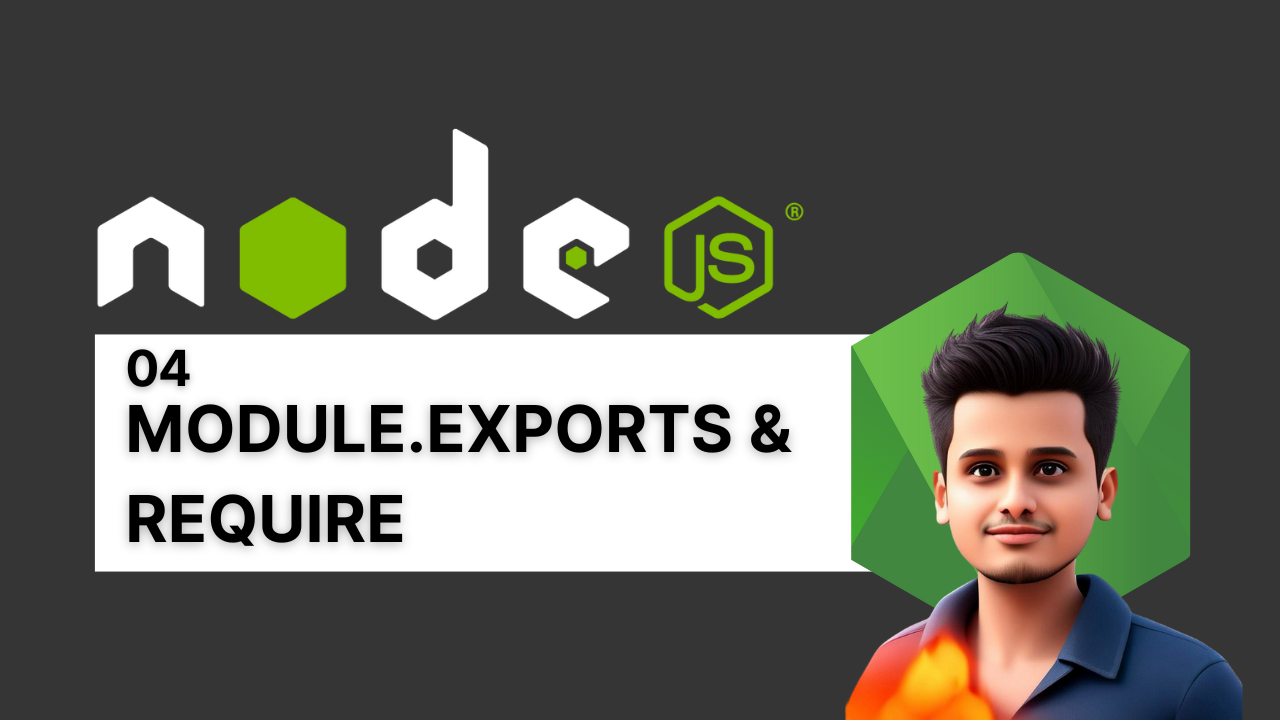
As you saw in the last episode, we wrote our first line of code in Node.js. Now, we could just keep adding whatever we want to app.js, and technically, it would work. But that's not the best way to do things because the file would get cluttered and hard to manage. Instead, we need multiple files. Basically, there should be one main entry file that runs the code, and other files will be connected to it. So, you'll use require to include different modules into your main file.

require
So, when you use require to include a new module into another module, the code in the required module runs first, and then the rest of the code in your file executes. You can use the require keyword anywhere in your Node.js code.
Note: You can’t directly access variables and functions from one module in another module just by using require. Even if the code runs, you can't directly access the code. For example, if a module sum.js has a function getSum(), and you import sum.js, you still can't access getSum() in your entry file. But why is that?
The reason is that Node.js modules are encapsulated, which means each module has its own scope. To access variables or functions from another module, you need to explicitly export them using module.exports or exports.
Modules protect their code by default. that one module be like:

Arey aise kaise nahi btayega, So to know variable and functions of that module, you have to export and import in the file you want to import.
sum module
console.log('I am sum module');
function calculateSum(a,b){
console.log("Sum is", a+b);
}
module.exports =calculateSum // the way you export ( remember its export+s not export )
app..js ( entry file )
const calculateSum= require('./sum.js') // the way you import
console.log("I am entry files");
calculateSum(4,5) // 9 is the output
Now app.js be like

How to export multiple data from a module
To export multiple things from a module in Node.js, you need to use an object to bundle them together and then import them as an object in another file. Here’s how you can do it with your multipleExport.js file:
var name ='Mohan'
function sayHello(name){
console.log(`Hello ${`name`}!`);
}
module.exports= { // this is the way you export multiple things
sayHello,
name,
}
and this is the way you import in app.js
// destructured : learn Destructuring
const {sayHello, name} = require('./multipleExport..js') // this is the way you imported
sayHello('Ashutosh') // Hello Ashutosh
console.log("Exported name is", name); // Mohan
// what will you get if you print modile
console.log(module.export) // {} emoty object
Common Js and ES Modules
What we've learned so far with require and module.exports is called CommonJS Modules or CJS. This is the traditional module system used in Node.js. But there's another module system called ES Modules (or ESM, mjs), which is the standard for JavaScript modules in modern web development.
To use ES Modules in Node.js, you need to set your project to use modules. Create a package.json file and include "type": "module" in it. This tells Node.js to use the ES Module system for your project.
// package.json
{
"type" : "module"
}
and now you can generally import and export as your front end projects
// in sum js
export function calculateSum(){....}
// in app js
import {calculateSum) from './sum.js' or './sum'
Remember: By default, Node.js uses the CommonJS (CJS) module pattern, which is the older way of handling modules. According to the JavaScript foundation, the future will favor ES Modules (ESM), but currently, most of the industry still uses CJS. CJS is synchronous, meaning it requires all files before running the next line of code, whereas ES6 Modules can be asynchronous, offering better performance. CJS runs in a non-strict mode, while ESM runs in strict mode. ES6/ESM is the default in React and new libraries. Printing module.exports in CJS returns an empty object by default.

Node.js also comes with built-in modules that you can require and import directly into your code. These modules are pre-installed with Node.js and provide various functionalities like file handling, HTTP requests, and more.
Definition of Module
A module is essentially a collection of code that remains private unless explicitly exported. This means you can organize your code into different modules, keeping them isolated and secure, only sharing what's necessary by using the exports or module.exports keywords to make functions or variables accessible to other modules.
Keys to learn
- Object destructuring
- Modules in JS
- Strict mode
- Difference between ES6 modules and CJS
- In-built Modules
Question to search
- Reasons why modules are protected by default ?
- Whats the difference between require and import and export vs module.exports
Key findings
- Modules are protected by default after requiring it will run bu can't be access until you export
- These are protected to avoid conflicts from other modules
- Common Js, EJS / ESModule , ESM, MJS ES6 Modules are two module patterns to access data within modules
- In CJS code runs in non strict mode, but in ESM pattern code runs in strict mode

And thats all for this episode knowing modules and require
I'm Rahul Aher, and I'm writing digital notes on Node.js. If you enjoy these notes, please share them with your friends. If you find any errors or have improvements, feel free to contribute by forking the repo. If you're interested in writing the next episode's notes, fork the repo and contribute. Let's learn together! Also, please consider giving a star to this repo. For any queries, let's connect here.
Thank you so much for reading. If you found it valuable, consider subscribing for more such content every week. If you have any questions or suggestions, please email me your comments or feel free to improve it.

Written by Rahul Aher
I'm Rahul, Sr. Software Engineer (SDE II) and passionate content creator. Sharing my expertise in software development to assist learners.
More about me